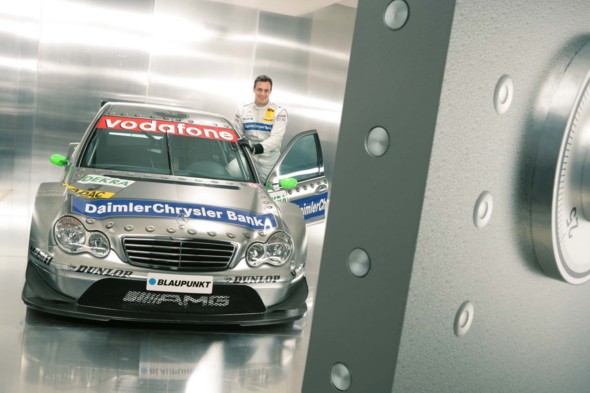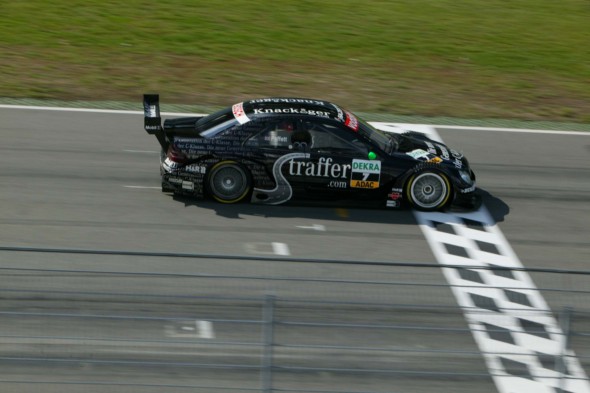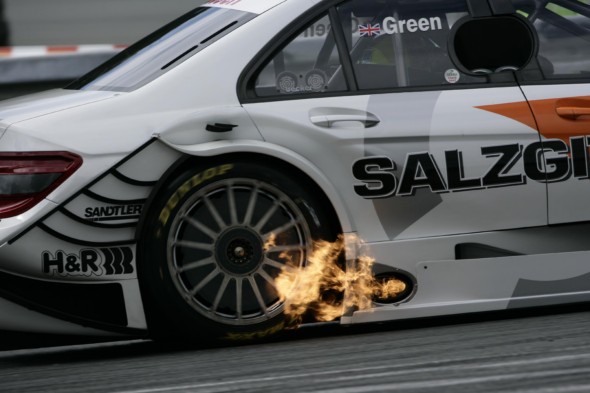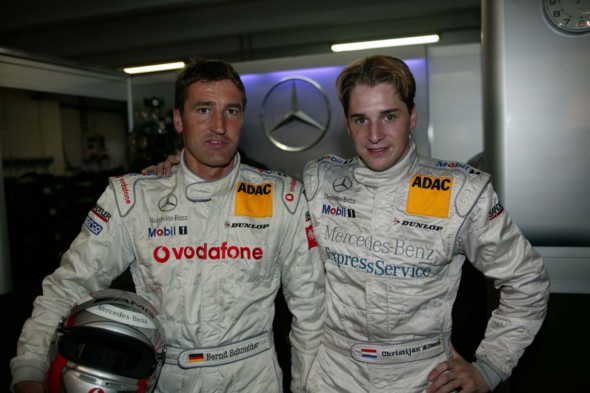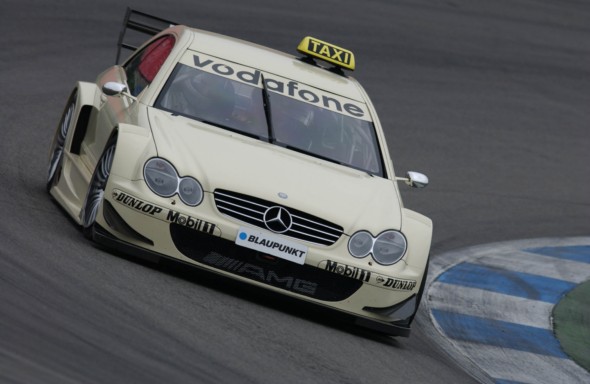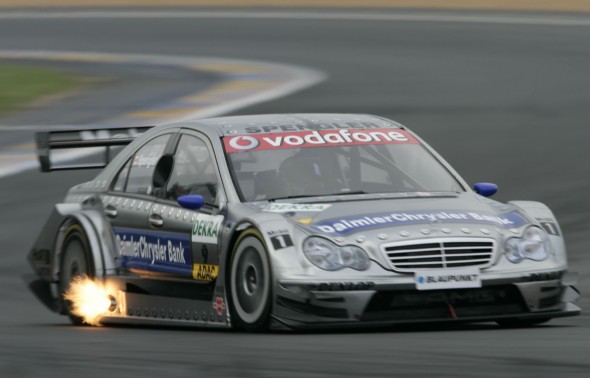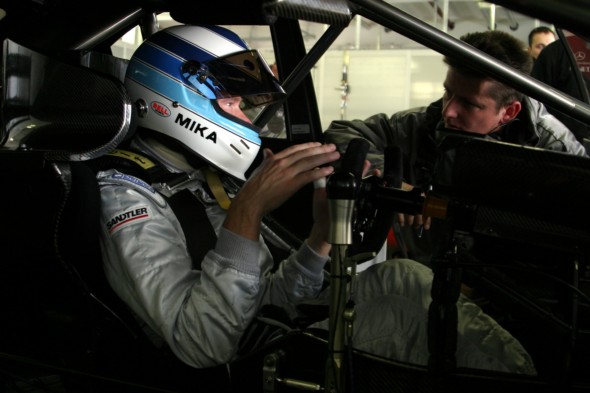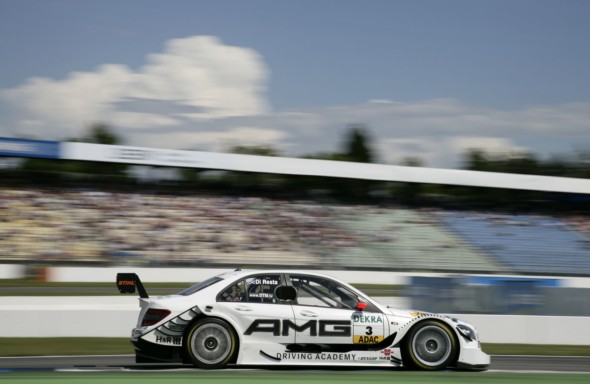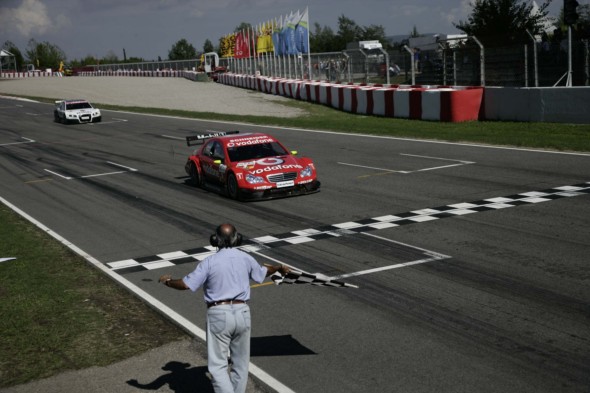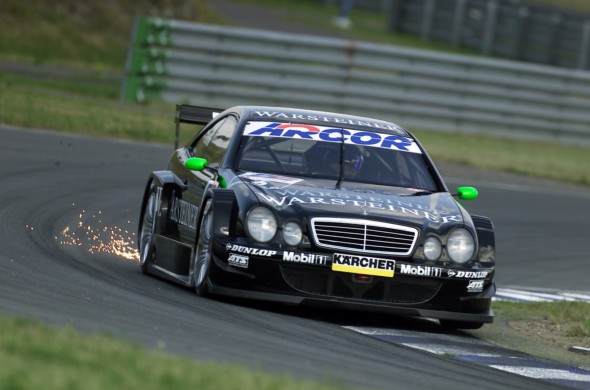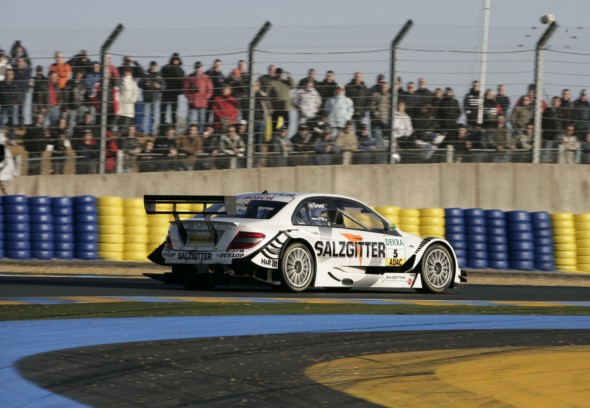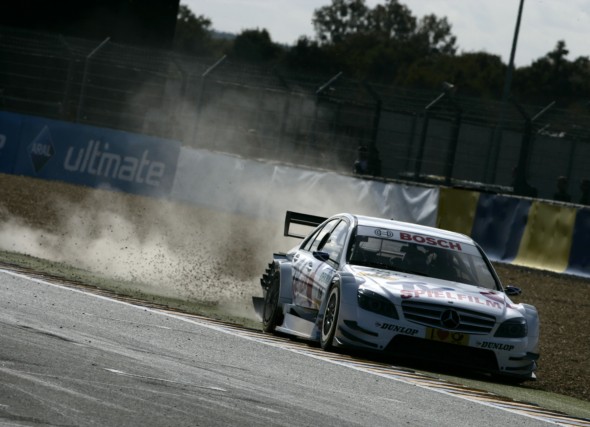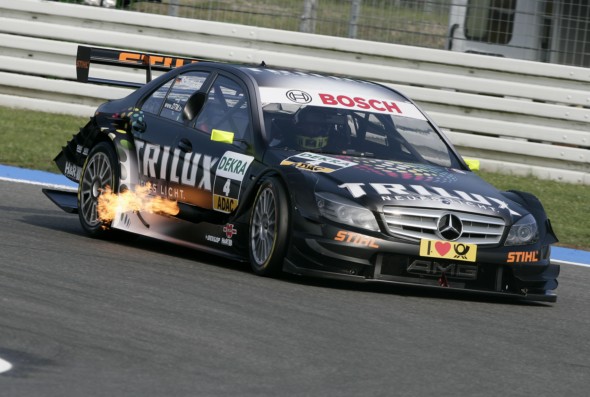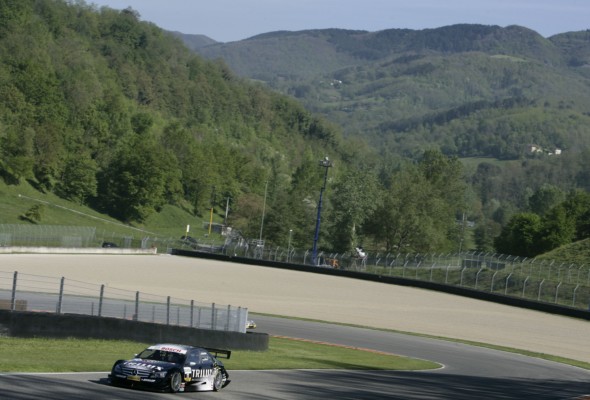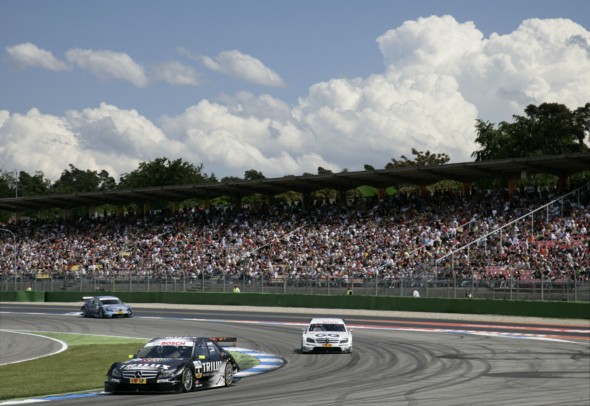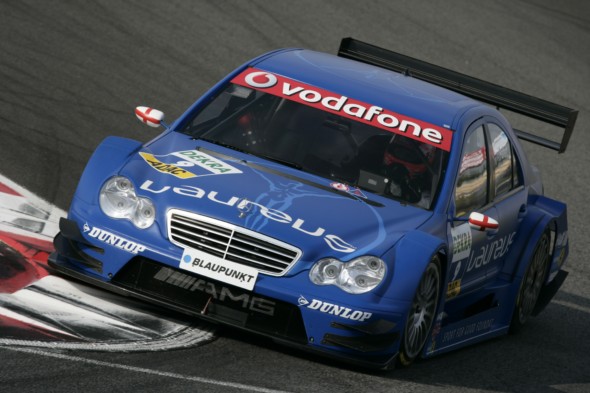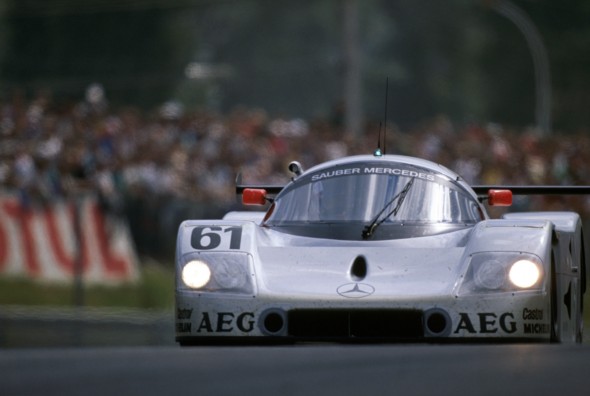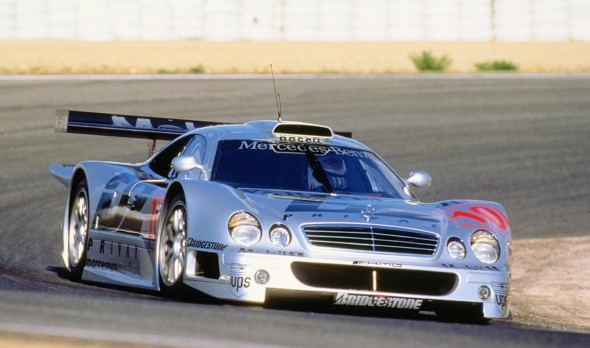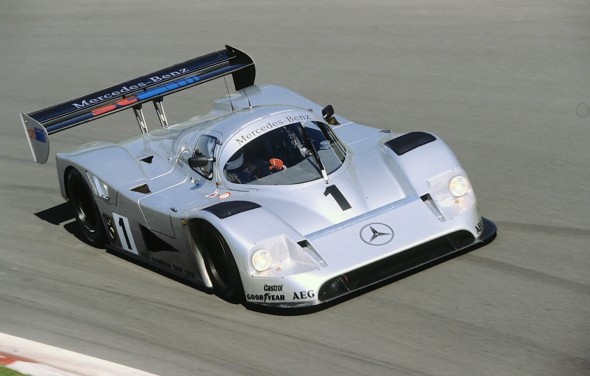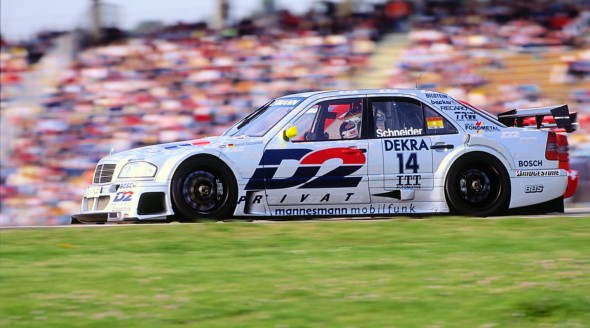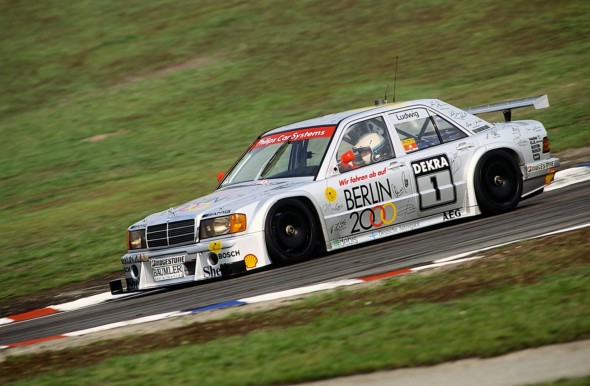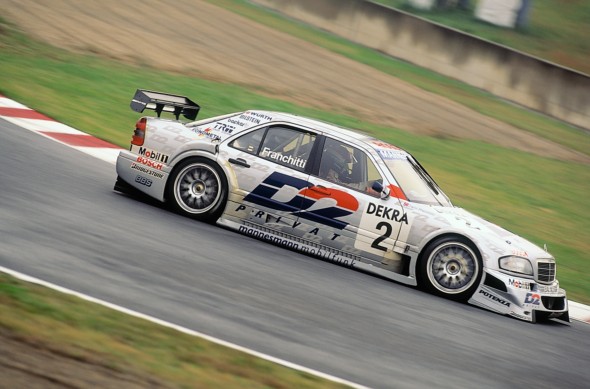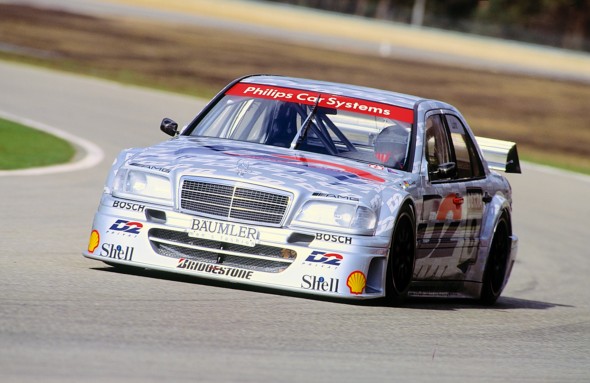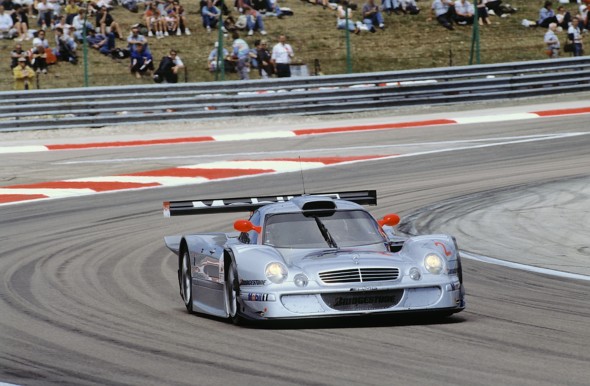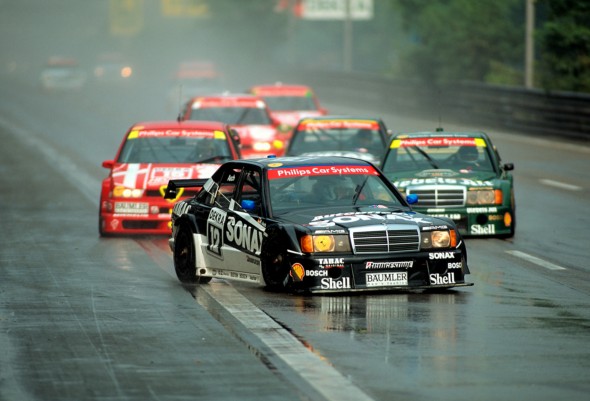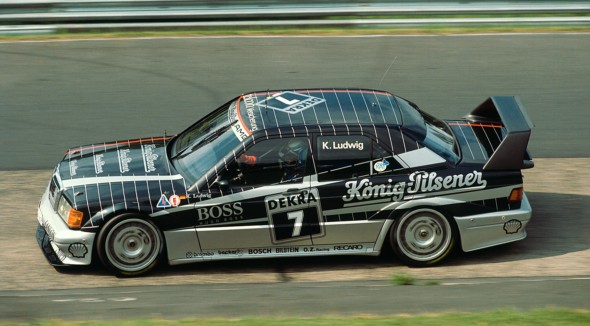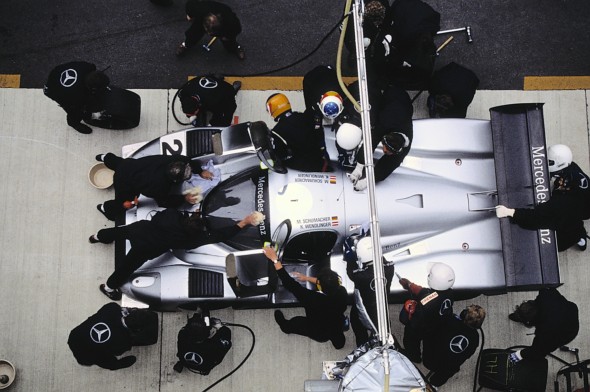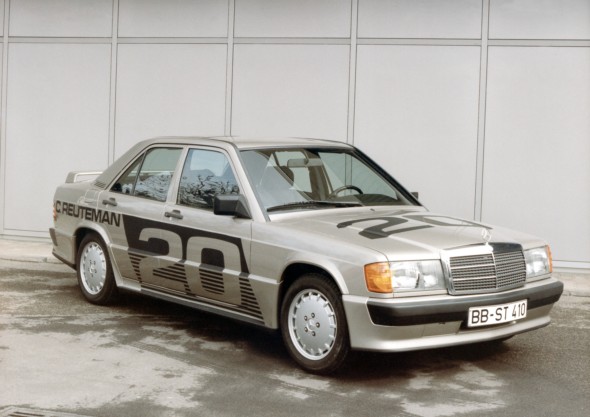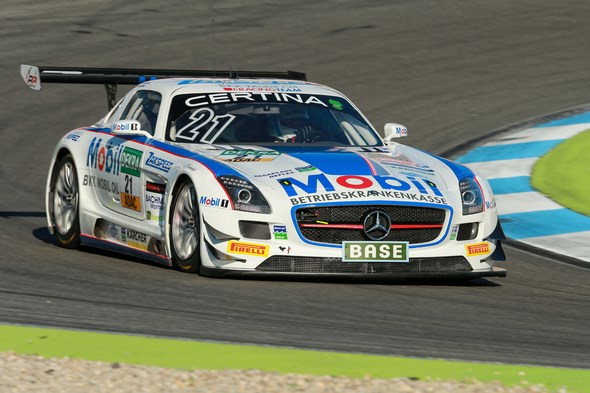Mercedes Return to the racetrack

- Early days in cooperation with the Sauber racing stable
- Championship victories with several different vehicles
- DTM draws the crowds
The 1980s and 1990s marked the return of Mercedes-Benz to the racetrack. Initially, in the years from 1985 to 1991, the star was carried by group C racing cars, followed by racing touring cars from 1986, and then the German touring car championship (DTM) and ITC from 1996. The process culminated with the return to motor sport at the highest level: Formula 1 racing.

Racing in the FIA GT championship was followed in 2000 by competition in the new German Touring Cars Championship (DTM). Mercedes-Benz drivers have now won five DTM championship titles (including four for Bernd Schneider), and have been runner-up seven times, and in third place on four occasions. Mercedes-Benz won the brand championship every year from 2000 to 2003, in 2005 and 2006, and again in the 2008 season.
The C 9 used from 1987 to 1989 was the first Sauber-Mercedes to race as a Mercedes-Benz Silver Arrow starting in 1989, although the car had various names during the construction period, according to the sponsorship arrangements. During the 1987 season, it was the
Kouros-Mercedes, then the Sauber-Mercedes until 1989, and finally started a race in 1990 as a Mercedes-Benz. Up until 1988, the engine for the C 9 was the M 117, taken from the C 8, until its replacement in 1989 with the new M 119 engine – also a V8, with a displacement of 4973 cc.
 Mercedes-Benz again competed in group C as an official works team from 1988 onwards. The Sauber-Mercedes C 9, developing over 700 hp (515 kW), won a total of five races, and in 1989 Sauber-Mercedes actually took the world championship with the C 9. For the 1989 season, the Sauber-Mercedes racers were fitted with the new V8 biturbo M 119 engine with four-valve technology, which was able to develop up 925 hp (680 kW) in short bursts. Along with a range of technical enhancements, the cars were also now painted in silver, as a clear signal that Mercedes-Benz was back on the race circuit. The new Silver Arrow won a total of 16 out of 18 races in 1989 and 1990, including the 24-hour Le Mans event in 1989, with Jochen Mass / Manuel Reuter / Stanley Dickens at the wheel.
Mercedes-Benz again competed in group C as an official works team from 1988 onwards. The Sauber-Mercedes C 9, developing over 700 hp (515 kW), won a total of five races, and in 1989 Sauber-Mercedes actually took the world championship with the C 9. For the 1989 season, the Sauber-Mercedes racers were fitted with the new V8 biturbo M 119 engine with four-valve technology, which was able to develop up 925 hp (680 kW) in short bursts. Along with a range of technical enhancements, the cars were also now painted in silver, as a clear signal that Mercedes-Benz was back on the race circuit. The new Silver Arrow won a total of 16 out of 18 races in 1989 and 1990, including the 24-hour Le Mans event in 1989, with Jochen Mass / Manuel Reuter / Stanley Dickens at the wheel.
1990 saw the arrival on the racetrack of the Sauber-Mercedes C 11, the successor to the C 9. This sports car prototype was the first Sauber car to have a carbon fibre chassis, providing outstanding rigidity. At the end of the season, the C 11 had won the world championship, including both the drivers’ and constructors’ titles. At the wheel were Jean-Louis Schlesser, already world champion in 1989, and co-driver Mauro Baldi. This was also the year the Mercedes-Benz Juniors Team was established, with drivers including Michael Schumacher, Heinz-Harald Frentzen and Karl Wendlinger.
1991 saw changes to the group C regulations, prohibiting supercharged engines and limiting displacement to 3.5 litres. Mercedes-Benz developed a new V12 engine to these specifications for the new C 291 racing car. This was the last Mercedes-Benz group C car, but it proved unable to replicate the victories of the C 9 and C 11 in the previous years.
1986 to 1996: German Touring Car championship and the International Touring Car series
In summer 1983, the new 190 E 2.3-16 model was on its way to breaking world records on the Nardo track. By now, Mercedes-Benz had ceased work on the rally version of the W 201, and was focusing on developing the compact class as a racing sports car for the racetrack. There had been indications of a possible return of Mercedes-Benz to international motor sport with this vehicle as early as 1984: for the official opening race at the new Nürburgring racetrack on 12 May 1984, Daimler-Benz AG lined up with 20 identical Mercedes-Benz 190 E 2.3-16 vehicles. The new, distinctively sports-style compact-class model had its press trial drive a few days before on the redesigned track. Behind the wheel were 20 former winners at the Nürburgring, either in the German Grand Prix or the 1000-kilometre event – including Jack Brabham, Hans Herrmann, Phil Hill, Denis Hulme, James Hunt, Alan Jones, Niki Lauda, Klaus Ludwig, Stirling Moss, Alain Prost, Keke Rosberg, Jody Scheckter, Ayrton Senna and John Surtees.
These drivers – whose names read like a ‘who’s who’ of motor sport – each drove one of these 190 E 2.3-16 vehicles, with engineering and looks substantially unchanged from the production model, around the new course. The most striking difference from the production car was the integrated roll cage. The opening race was won by Ayrton Senna, then just 24 years of age, and already making a name for himself as a great up-and-coming Formula 1 driver.
In 1985, the 190 E 2.3-16 was type-approved for racing in groups A and N. The main priority for Mercedes-Benz was the international German Touring Car Championship. The first 300-hp (221-kW) 190 E 2.3-16 vehicles entered in the group A championship in 1986 were driven by a number of private teams, including AMG, and Volker Weidler ended the season as runner-up in the championship with the racing touring car, powered with a 16-valve engine prepared by AMG. Then, in 1988, five teams entered the DTM championship with works support from Mercedes-Benz. Roland Asch was second in the overall standings for the season with his 190 E 2.3-16 group A vehicle. This season also marked the definitive return of Mercedes-Benz to motor racing, since they also officially entered the group C championship as a works team.
In 1989, the 190 E 2.5-16 Evolution was developed on the basis of the Mercedes-Benz 190 E 2, as a new variant specifically designed for competition in the German Touring Car Championship. As the name of the car indicates, it had a new engine under the bonnet – a 2.5-litre six-valve unit developing 333 hp (245 kW). To get the car’s weight down to the required 1040-kilogram limit, the engineers removed almost all the interior trim, and many body components, such as the bonnet, boot lid and spoiler, were made of kevlar.
1990 saw the arrival of the AMG Mercedes 190 E 2.5-16 Evolution II racing touring car, now with an engine power rating of 373 hp (274 kW). Work on the car had started in August 1989. In order to gain type approval for the car, Mercedes-Benz had to produce at least 500 of them, and in May 1990 the last of the 502 units made rolled off the production line in the Bremen plant. AMG then took over as the partner responsible for the enhancements and equipment of the racing sports car. The racing debut of the Mercedes-Benz 190 E 2.5-16 Evolution II took place on 16 June 1990, on the north loop of the Nürburgring track. Following the DTM final race on 15 October 1990 at the Hockenheimring, all the works-supported teams moved to the Evo II stand.
There was plenty of thrilling racing against tough competition from Audi, BMW and Opel, but the speed of the Mercedes-Benz touring cars saw them gain increasing success, which soon translated into championship titles. In the 1991 season, Klaus Ludwig was championship runner-up in his Mercedes-Benz, and the Stuttgart firm became DTM brand champions for the first time. Ludwig then won the drivers’ championship in 1992, and the firm also again won the brand title. Kurt Thiim was second in the driver’s standings, and Bernd Schneider third, forming a clean sweep in the driver stakes.
If the car’s debut at the Nürburgring is included, 1993 was the tenth racing season of the Mercedes-Benz 190 E. For this year, Mercedes-Benz developed the AMG Mercedes 190 E Class 1a, to take over from the car that had won the 1992 championship, the AMG Mercedes 190 E 2.5-16 Evolution II. The new name reflected changes to the DTM regulations, whereby the racing sports cars had to be based on a minimum number of 2500 units built in twelve consecutive months. Accordingly, the basis for the Class 1 vehicles was the Mercedes-Benz 190 E 2.5-16, rather than the highly successful Evo II, of which only 500 units had been produced.
The AMG Mercedes 190 E Class 1 weighed 1000 kilograms, as required by the regulations. This made it 20 kilograms heavier than the 1992 car. A new feature was the position of the engine, which was placed five centimetres lower and 12 centimetres further to the rear than in the Evo II. Also new were parts of the body and the front wheel suspension, now comprising wishbones, MacPherson strut and stabiliser. The engine specifications were virtually identical to those of the Evo II. Roland Asch was runner-up in the drivers’ championship in 1993 in a 190 E Class 1, followed by Bernd Schneider, and the brand championship again went to Mercedes-Benz.
1994 was the first year that Mercedes-Benz entered a C-Class-based racing touring car in the DTM. The 2.5-litre six-cylinder engine was based on the E 420 powerplant, with the racing version developing over 400 hp (294 kW). This car, whose body concealed engineering solutions designed solely for racing, gave Klaus Ludwig the drivers’ title in the 1994 German Touring Car championship, followed by fellow team member Jörg van Ommen. And Mercedes-Benz won its fourth consecutive brand title.
In 1995, a sister series was established alongside the DTM, with the International Touring Car series (ITC). Mercedes-Benz entered that year’s competition with an enhanced AMG Mercedes C-Class racing touring car, with the driver’s seat moved back and towards the middle, as a safer position for the driver. The unitized body structure with integrated roll cage was an integral feature of the design, giving this generation of racing touring cars up to 300 percent greater rigidity than in previous designs. Bernd Schneider was a convincing winner of the DTM and ITC, and Mercedes-Benz also took the brand championship in both series.
After the German Touring Car championship ended in 1995,
Mercedes-Benz entered the new 1996 racing version of the C-Class in the International Touring Car championship, which also came to an end that year. In the years between 1986 and 1996, Mercedes-Benz established itself as the most successful brand over the entire DTC/ITC period, thanks to its ultra-fast racing touring cars based on the 190 E and the C-Class. They had notched up 84 wins and five brand titles, as well as being runners-up in the brand championship on ten occasions.
In subsequent years, Mercedes-Benz entered the FIA-GT championship with the CLK-GTR racing touring car of 1997 and the Mercedes CLK-LM racing touring car of 1998. The CLK-GTR, jointly developed with AMG, was the first production racing car with a Daimler-Benz mid-engine. The six-litre V12 unit developed around 600 hp (441 kW). With a variant engine, the car was also available for sale as a sports car for use on the roads, for customers seeking this type of vehicle. Bernd Schneider won the GT1 drivers’ championship in 1997.
The CLK-LM took over during the 1998 racing season. The new racing touring car powered with a V8 engine was initially developed specifically for the Le Mans 24-hour race. While Mercedes-Benz did not win the marathon event in June 1998, the rest of the season was extremely successful, and Klaus Ludwig was the 1998 FIA GT champion in his CLK-LM. AMG Mercedes also won the constructors’ title for the second time.
Since 2000: the German Touring Cars championship (DTM)
The DTM returned to the racetrack in 2000, although the abbreviation now stood for the name of a new racing series, the German Touring Car Masters. The racing car builders at Hans Werner Aufrecht (HWA) in Affalterbach developed the Mercedes-Benz CLK-DTM racing touring car to enable Mercedes-Benz to start in the new DTM. This new touring vehicle managed to reconcile the conflicting objectives of low development and racing costs on the one hand, and top performances to bring in the crowds on the other. This was the compromise agreed upon between the participating manufacturers, following the cost explosion in the old DTM.
The DTM regulations were a bold new departure, designed to ensure competition on an equal footing and to keep costs under control. The document defined rigorous constraints for the designers, calling for maximum creativity within the series rules. The backbone of the rear-wheel driven Mercedes-Benz coupe with a four-litre engine developing around 450 hp (331 kW) was a mesh frame to which the engine and wheel suspension were bolted. An additional safety cage structure, made from carbon fibre composites, enclosed the seat and head support, pedals, selector level, steering column bearing and belt system. The radiators were in front of the front axle, in two parts to create just enough space for a one-metre-long additional carbon fibre crash member. The contours of the body over the safety cage, comprising the roof, side walls and steel panel doors, have the same outline as in the Mercedes-Benz CLK production model.
The eight-cylinder engine designed by HWA had no direct relationship with any other Mercedes-Benz engine. Two air restrictors with a diameter of 28 millimetres limited the intake air, thereby limiting both the power and engine speed. The latter was restricted to 8000 rpm, whereas the torque reached more than 400 Newton metres. Gears were changed sequentially, with defined ratios for the six gears. There was, however, a choice of nine hub drives, so the car could be adjusted according to the terrain. Bernd Schneider won the drivers’ championship title for the 2000 season with his D2 AMG, and the HWA/AMG team won the team title.
For 2001, HWA designed a new CLK-DTM car, which differed in many details from its predecessor: the rear fender flares were formed differently, and there were also changes to the rear wheel ventilation and the front skirt. The engine had new intake points and airflow limiters. The power rating was around 460 hp (338 kW) at 8000 rpm. By two races before the final event for the season, Bernd Schneider had successfully defended his championship title with an unbeatable lead over the rest of the field. Schneider was runner-up for Mercedes-Benz in 2002, and then, in 2003, the Stuttgart team’s DTM coupes achieved a clean sweep of the drivers’ championship (Bernd Schneider, Christijan Albers and Marcel Fässler) – and the 2004 season yielded a fourth consecutive brand championship.
2004 marked a new departure in the DTM series, since the new vehicles were derived from medium-sized sedans rather than coupes. Accordingly, Mercedes-Benz entered the competition with a new AMG-Mercedes C-Class, but with the same engine as in the CLK versions used since 2000, i.e. the coupes driven by the Mercedes-Benz team juniors. Gary Paffett come second in the drivers’ championship for the season, followed by Christijan Albers. Audi won the brand championship in 2004.
In the 2005 season, Mercedes-Benz was represented in the DTM with seven drivers from five countries. One of them was former Formula 1 driver Mika Häkkinen, returning to active involvement in motor sport at the wheel of a AMG-Mercedes C-Class, following test drives in 2004. Features of the new-generation vehicle included changes to the air flow breakaway edge on the rear spoiler, in line with modified DTM aerodynamics rules. Gary Paffett won the driver’s title, and Bernd Schneider was the 2006 champion in his AMG-Mercedes C-Class. Mercedes-Benz took the brand championship in both years.
At the 2007 Geneva Auto Show, Mercedes-Benz presented the new AMG-Mercedes C-Class, similar to the W 204 production model. Its predecessor models had now accumulated 54 wins in 106 races during the years from 1994 to 1996, and from 2004 to 2006. This makes the racing touring car based on the C-Class the most successful car ever in the DTM.
March 2006 saw work begin on the development of a new racing car at HWA. The car included a completely new design and manufacturing process for doors, front windscreen and bonnet, to adjust the C-Class vehicle to the new silhouette. Just ten months after work had started, the AMG-Mercedes C-Class appeared on the racetrack for the first time in Estoril, Portugal. At the wheel were Bernd Schneider and Bruno Spengler, DTM champion and runner-up in 2006.
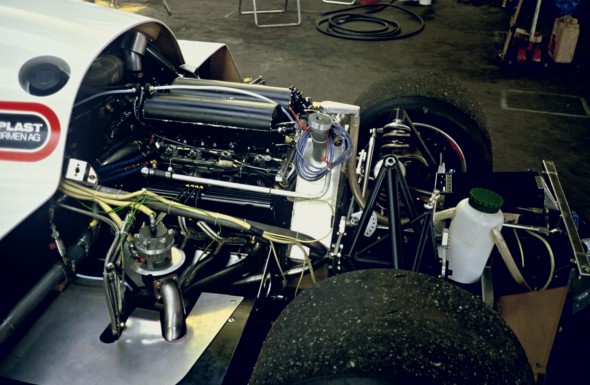 The eight-cylinder V engine with cylinder angle of 90 degrees, displacement of four litres and four valves per cylinder had been further enhanced. With the two airflow limiters required by the rules, with a diameter of 28 millimetres each, the engine now developed 470 PS (350 kW) at 7500 rpm, with maximum torque of 500 Newton metres. The engineers also modified the wheel suspension to further enhance the car’s driving dynamics and handling qualities. Bruno Spengler was runner-up in the DTM championship in 2007, with Paul di Resta recording the same result in 2008. Mercedes-Benz was also once again the DTM brand champion in 2008.
The eight-cylinder V engine with cylinder angle of 90 degrees, displacement of four litres and four valves per cylinder had been further enhanced. With the two airflow limiters required by the rules, with a diameter of 28 millimetres each, the engine now developed 470 PS (350 kW) at 7500 rpm, with maximum torque of 500 Newton metres. The engineers also modified the wheel suspension to further enhance the car’s driving dynamics and handling qualities. Bruno Spengler was runner-up in the DTM championship in 2007, with Paul di Resta recording the same result in 2008. Mercedes-Benz was also once again the DTM brand champion in 2008.


